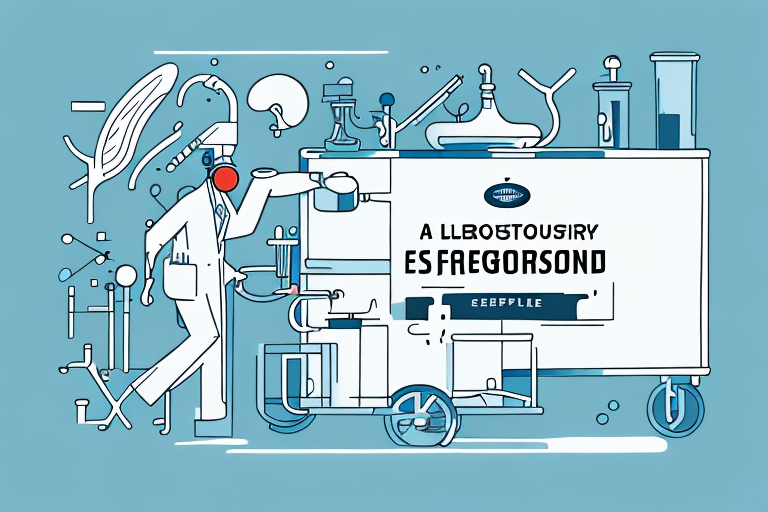Methods for Processing Specimens for Transport: A Comprehensive Guide
Specimens are collected for various purposes, such as diagnosing infections, monitoring treatments, and assessing overall health. Proper processing of specimens is crucial to ensure accurate and reliable results. In this comprehensive guide, we will discuss the different methods for processing specimens for transport.
Why Proper Specimen Processing is Crucial for Accurate Results
Specimen processing involves preparing and handling the collected sample for laboratory analysis. Mishandling specimens can significantly impact sample quality and result accuracy. If not handled correctly, samples may become contaminated, degraded, or unsuitable for analysis, leading to inaccurate results. Such inaccuracies can have serious consequences, including misdiagnosis, inappropriate treatment, and delayed care. Proper specimen processing ensures that laboratory analyses are reliable and meet the expectations of healthcare providers and patients.
Additionally, proper specimen processing can reduce the turnaround time for test results. Correctly processed specimens are more likely to yield accurate and reliable results, enabling healthcare providers to make informed decisions about patient care more swiftly. This is especially critical in emergency situations where timely decisions are essential. By prioritizing proper specimen processing, healthcare providers can ensure that patients receive the best possible care promptly.
The Different Types of Specimens and Their Unique Transportation Needs
Specimens come in various forms, such as blood, urine, feces, tissue, and more. Each type of specimen requires specific handling and transport conditions. For instance, urine may require a preservative to prevent bacterial overgrowth, and to maintain the sample's integrity during transport, it should be kept at a cool temperature. Understanding how different specimens need to be processed and transported is essential to avoid any issues.
Blood Specimens
Blood samples must be stored at controlled temperatures to prevent hemolysis and degradation of analytes. Using appropriate anticoagulants and proper labeling is crucial for accurate testing.
Tissue Specimens
Tissue samples need to be kept in a sterile environment to prevent contamination and degradation. Often, they require refrigeration or freezing depending on the intended analysis.
Fecal and Urine Specimens
These specimens may need preservatives to inhibit bacterial growth. Maintaining a cool temperature during transport is also important to preserve integrity.
Another important factor to consider when transporting specimens is the distance and time it takes to reach the testing facility. For example, specimens transported over long distances may require additional packaging to prevent damage or contamination during transit. Additionally, some specimens may require special handling, such as maintaining a sterile environment for tissue samples to prevent degradation. Following proper guidelines and regulations for transporting each type of specimen is crucial to ensure accurate and reliable test results.
Best Practices for Collecting Specimens for Transport
Proper specimen collection is the first step in the processing and transport process. To obtain reliable results, specimen collection must be performed correctly, adhering to standard procedures. Best practices for collecting specimens include:
- Ensuring proper patient identification
- Using aseptic techniques to prevent contamination
- Employing appropriate collection devices
- Accurately labeling the specimen
Another critical aspect of specimen collection is timing. Some tests require specimens to be collected at specific times of the day or after certain preparations, such as fasting. Following the healthcare provider's or laboratory's instructions ensures accurate results.
Additionally, proper storage and transport of the specimen are essential to maintain its integrity. Specimens should be stored at the appropriate temperature and transported promptly to prevent degradation or contamination. Using suitable packaging and labeling ensures that the specimen is not damaged during transport and can be easily identified upon arrival at the laboratory.
Assessing Specimen Integrity: Common Issues and Solutions
Maintaining specimen integrity is vital for ensuring accurate laboratory results. Assessing specimen quality involves examining physical characteristics such as color, odor, clarity, and viscosity. Unusual findings like hemolysis, coagulation, and turbidity can compromise result validity.
Common Issues
- Contamination during collection or transport
- Degradation due to improper storage conditions
- Hemolysis in blood samples affecting test results
Solutions
- Using appropriate transport media for each specimen type
- Maintaining specimens at recommended temperatures
- Implementing quality control procedures to detect potential issues
Another crucial factor in assessing specimen integrity is the time between collection and testing. Delayed testing can lead to changes in the specimen, such as bacterial growth or degradation of certain analytes. Adhering to proper storage and transportation protocols minimizes the risk of specimen degradation.
Moreover, considering the patient's medical history and medications is important when assessing specimen integrity. Certain medications or medical conditions can alter the specimen's composition, leading to inaccurate results. Communicating relevant information to the laboratory ensures proper testing and accurate interpretation of results.
Choosing the Right Transport Medium for Your Specimen Type
Not all specimens can be transported without preservation or transport media. Transport medium is a solution that helps preserve the specimen's quality during transport. The choice of medium depends on the specimen type, susceptibility to degradation, and the organisms that need to be cultured or identified. Understanding the proper use of transport media is critical to ensuring sample integrity and, ultimately, accurate laboratory results.
Viral Specimens
Viral specimens require transport media that maintain the virus's viability. Viral transport media typically contain buffer solutions to maintain pH and osmolarity, as well as antibiotics to prevent bacterial and fungal growth.
Bacterial Specimens
Bacterial specimens may require different types of transport media depending on the bacteria being cultured. Some bacteria require anaerobic conditions, achieved through the use of anaerobic transport media.
Consulting with the laboratory or healthcare provider to determine the appropriate transport medium for your specific specimen type is essential.
How to Label and Package Specimens for Safe Transportation
Labeling and packaging are crucial steps in specimen transport to ensure safe handling and delivery. Proper labeling should include patient identification, specimen type, and collection date. Specimens should be packaged using appropriate containers, with secondary packaging to provide an additional layer of protection. Proper packaging is essential to prevent leakage, breakage, or contamination during transport.
Temperature Requirements
Consider the temperature requirements of the specimen during transport. Some specimens, such as blood or urine, may require refrigeration or freezing to maintain their integrity. Using appropriate packaging materials, such as insulated containers or dry ice, helps maintain the required temperature range.
Compliance with Regulations
Following all applicable regulations and guidelines for specimen transport is imperative. This includes requirements for labeling, packaging, and documentation, as well as restrictions on certain specimen types or transport methods. Non-compliance can result in delays, fines, or legal consequences.
Understanding Regulations and Guidelines for Transporting Clinical Samples
Transporting clinical samples involves adhering to local, national, and international regulations and guidelines. These regulations vary depending on the specimen type, destination, and mode of transport. Following the rules for shipping clinical samples minimizes the risk of exposure and ensures that samples reach their destination safely and securely.
International Regulations
Different countries may have varying regulations and guidelines for transporting clinical samples. Some countries require additional documentation or permits for specific sample types and have unique packaging and labeling requirements. Researching and complying with both the country of origin and destination regulations is crucial to avoid delays or issues during transport.
Working with Reputable Couriers
Collaborating with reputable couriers or shipping companies experienced in handling clinical samples ensures proper handling and delivery, reducing the risk of non-compliance and sample mishandling.
Tips for Shipping Specimens Internationally: Customs, Documentation, and More
Shipping specimens internationally requires careful attention to customs requirements, documentation, and considerations for different time zones. Proper documentation is essential, including shipping manifests, customs declarations, and airway bills. Special attention should be paid to import/export regulations and packaging requirements in the respective countries. Partnering with a third-party logistics provider experienced in international shipping can help avoid potential issues.
Specimen-Specific Requirements
Different specimens have varying requirements for packaging and shipping, such as temperature control or special handling. Researching and understanding these requirements before shipping ensures specimens arrive safely and in good condition.
Managing Shipping Delays
Considering potential delays or disruptions in the shipping process, such as customs clearance delays, unexpected weather events, or transportation issues, is important. Having a contingency plan and maintaining communication with all parties involved can minimize the impact of any disruptions, ensuring specimens arrive at their destination promptly and safely.
Traceability and Chain of Custody: Ensuring Accurate Tracking Throughout the Transportation Process
Traceability and chain of custody are critical during the transport process. Traceability involves tracking the specimen from collection through transportation to the laboratory, while chain of custody accounts for who handled the specimen and when. Accurate tracking helps prevent loss or misplacement of samples and promotes accountability in case of any mishaps.
Maintaining Sample Integrity
Ensuring accurate tracking prevents specimens from being tampered with or contaminated during transportation. This is especially important for forensic or legal cases where samples may serve as evidence. Proper traceability and chain of custody procedures ensure that samples remain admissible in court and can support legal cases effectively.
Implementing Effective Tracking Systems
Utilizing digital tracking systems can enhance traceability by providing real-time updates on specimen location and status. Implementing standardized protocols for documenting specimen handling ensures consistency and reliability in the transportation process.
How Innovative Technologies are Revolutionizing Specimen Transportation
Rapid advancements in technology have significantly influenced healthcare sectors, including specimen processing and transportation. Innovative technologies are emerging to make the process more efficient, cost-effective, and reliable while improving patient care.
Digital Tracking Systems
Digital tracking systems enable real-time monitoring of specimen locations, reducing the risk of loss or mishandling. These systems can provide alerts and updates, ensuring that specimens are transported securely and promptly.
Smart Transport Containers
Sensors embedded in transport containers can monitor conditions such as temperature, humidity, and light exposure. This ensures that specimens are transported under optimal conditions, maintaining their integrity and suitability for analysis.
Automated Documentation
Automated documentation systems streamline the labeling and tracking process, reducing human error and enhancing traceability. These systems can integrate with laboratory information systems (LIS) to provide seamless data flow and record-keeping.
Overcoming Challenges in Specimen Processing and Transport: Expert Insights
While proper specimen processing and transport are essential for accurate laboratory results, various challenges can arise during the process. Some of these challenges include maintaining sample integrity during transport, handling specimens in extreme temperatures, and complying with ever-evolving regulations.
Maintaining Sample Integrity
Ensuring samples remain uncontaminated and unaltered during transport is a primary challenge. Implementing robust protocols and using appropriate transport media and containers can mitigate these risks.
Handling Extreme Conditions
Specimens may be exposed to extreme temperatures or environmental conditions during transport. Utilizing insulated containers, temperature-controlled packaging, and real-time monitoring can help maintain optimal conditions.
Regulatory Compliance
Staying updated with the latest regulations and guidelines is essential for compliant specimen transport. Continuous education and collaboration with regulatory experts can help organizations navigate complex compliance landscapes.
Overcoming these challenges requires expertise, problem-solving skills, and a commitment to continuous improvement. By staying informed about new methodologies and regulatory requirements, healthcare providers and laboratories can enhance the efficiency and reliability of specimen processing and transport.
In conclusion, proper processing of specimens for transport is a critical step that requires attention to various factors, including collection, transport media, labeling, packaging, and regulations. Understanding and implementing best practices for handling and transporting specimens ensures accurate and reliable laboratory results, ultimately leading to better patient care. This comprehensive guide provides essential insights and knowledge to optimize specimen processing and transport, contributing to improved healthcare outcomes.






















